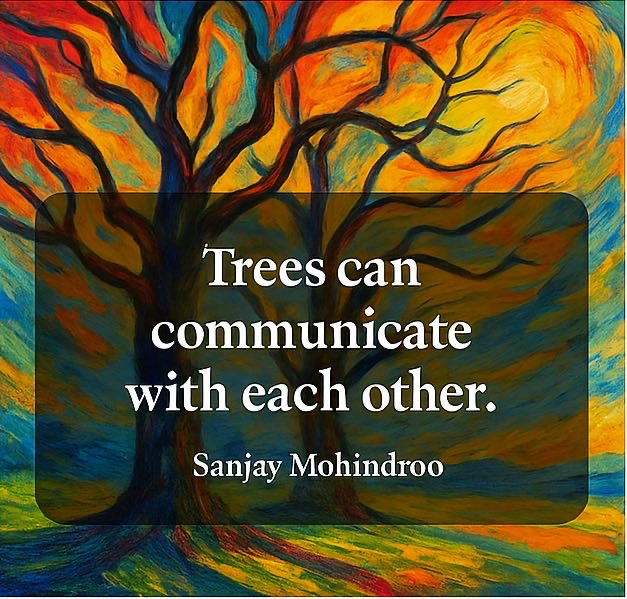
Sanjay Mohindroo
Trees can talk? Yes, and the forest has a voice. Here's how trees share, care, and connect.
🟢 The Forest is Alive
Nature’s Hidden Network is Real
Picture a quiet forest. Tall trees. Rustling leaves. Sunlight sliding through the canopy. Calm, right?
Not quite.
Beneath that peaceful surface is a world buzzing with conversation. Trees talk. They help each other. They care.
Thanks to scientists like Suzanne Simard and Peter Wohlleben, we know trees connect through underground networks. This isn’t a wild guess—it’s proven. Let’s explore how trees truly communicate.
🌐 The Wood Wide Web
A Forest Connected Below Ground
Deep in the soil lies a massive network called the mycorrhizal network. It's made of fungi and tree roots. Think of it as the internet for forests.
Fungi form thin threads—hyphae—that plug into tree roots and stretch across the forest floor. Trees trade sugars for nutrients. But this is more than trade—it’s teamwork.
Trees also send chemical messages through these fungal threads. A tree under insect attack might alert others, triggering them to activate defenses.
This is the #WoodWideWeb in action.
🌳 Mother Trees and Family Values
Trees Look After Their Own
Some trees act like parents. These “mother trees” are large, older trees connected to many younger ones.
They send nutrients to saplings in the shade. They keep them alive in harsh seasons. Even as they die, they transfer nutrients to their “children.”
This isn’t competition—it’s community.
Forest motto? “You grow, I grow.”
#TreeFamily #MotherTreeMagic
🚨 Warning Bells in the Breeze
Trees Sense Danger—and Spread the Word
In the African savannah, when a giraffe chews on an acacia, the tree releases bitter chemicals to make its leaves taste bad.
Cool, right? It gets better.
That same tree sends out a gas—ethylene—warning nearby acacias. They respond by making their leaves bitter too.
Trees also attract predators to eat the insects attacking them. Talk about plant-level strategy.
#TreeSignals #NatureDefense
🤝 Kindness in the Canopy
Trees Share, Support, and Sometimes Sacrifice
Trees don’t live alone. They work together.
Stronger trees send food to weaker ones. Different species—like fir and birch—exchange nutrients depending on the season.
They close their leaf pores together during droughts. They sense when a neighbor is sick. Even in death, they help others live.
It’s not survival of the fittest. It’s survival through friendship.
#TreesTogether #ForestCommunity
🔊 The Sound of Sap and Silence
Can Trees Hear—or Even Speak?
Research shows plant roots may react to sound. Some grow toward the noise of running water. Others vibrate quietly, which might be their version of talking to themselves.
It's still early research—but promising. We may not hear trees, but the forest is never silent. #PlantCommunication #SilentSpeech
🧠 The Intelligence of Trees
Redefining What it Means to Be Smart
Trees learn. They adapt. They remember.
Some trees recall past droughts and adjust their water use. Others pass on survival tips through their root networks. They don’t have brains. But they make decisions. They solve problems. That’s a kind of intelligence we’re just beginning to respect. #TreeWisdom #SmartForest
💚 A New Way to See the Forest
Respect, Wonder, and Hope
A walk in the woods is like stepping into a living conversation. Every tree hums with the connection. Every root holds a message. This changes how we see forests. They’re not just groups of trees—they’re communities. Systems that think, respond, and remember. To listen. #ForestsSpeak #TreeCommunication #NatureHeals
🌟 Listen to the Trees
Trees send messages. They remember. They care.
They don’t need words. They use chemistry, sound, and light. Through air and soil, they’re talking—always. Let’s listen. Let’s respond with care. #TreeTalk #ListenToNature